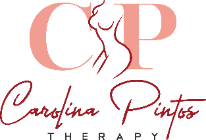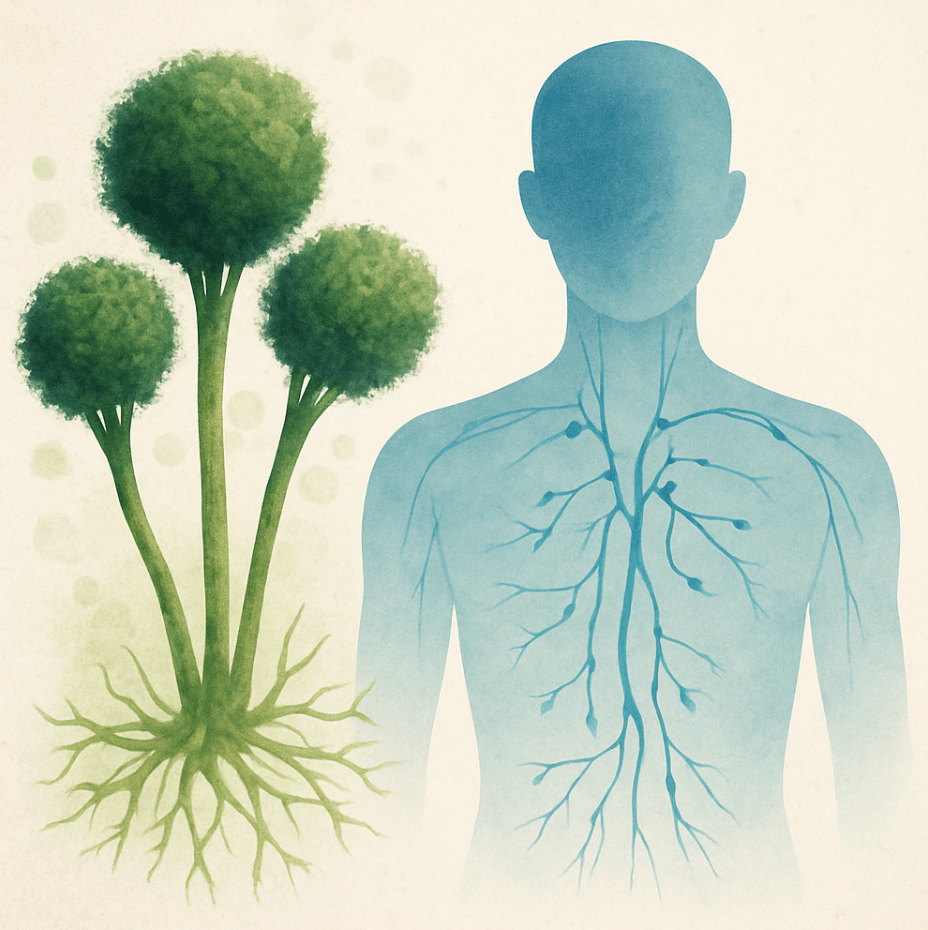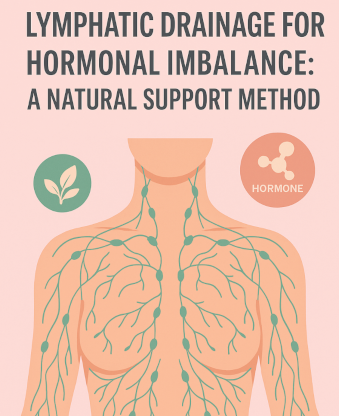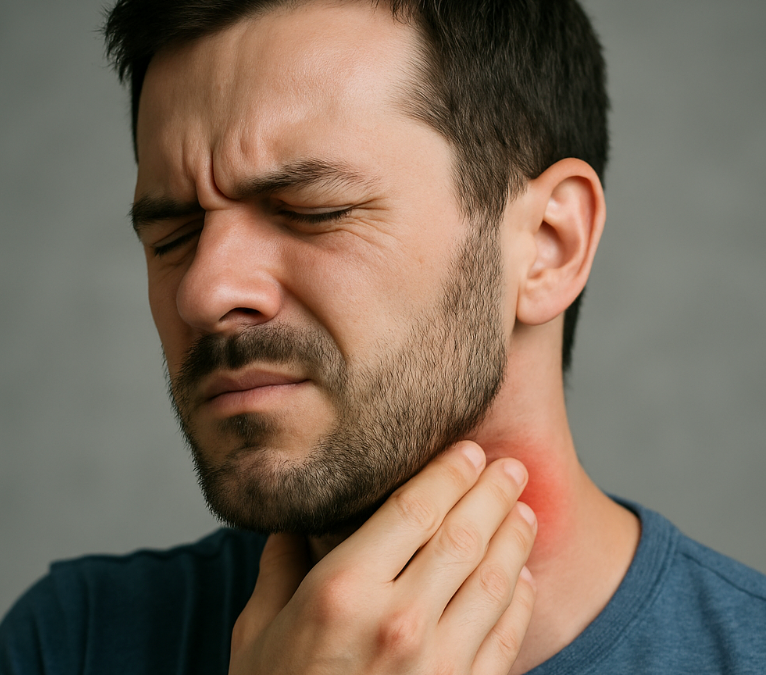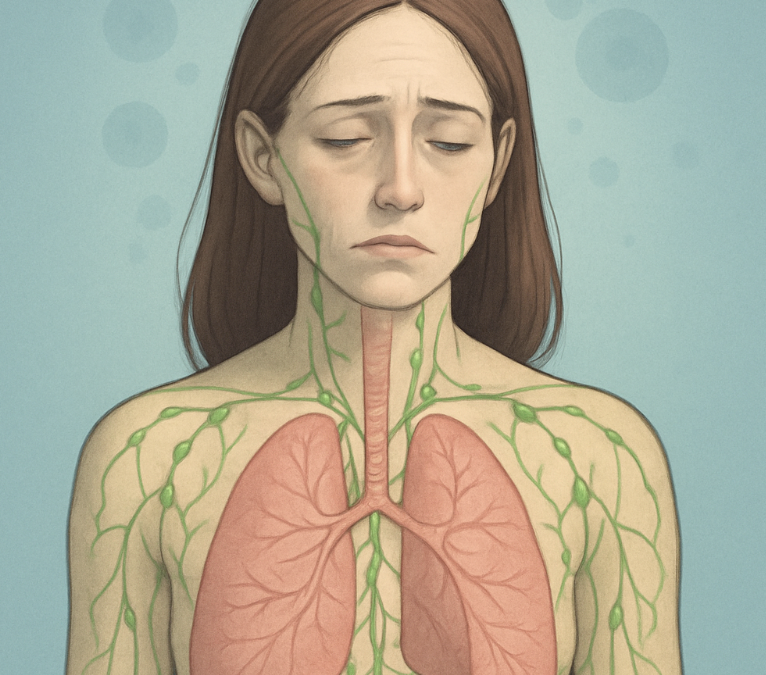Mold exposure is a growing public health concern—particularly for individuals living or working in water-damaged buildings. Invisible and often undetected, toxic molds can trigger a wide range of health issues, from respiratory distress and chronic fatigue to neurological symptoms and immune dysregulation. While many people focus on removing the mold source, a crucial aspect of recovery often goes overlooked: how the lymphatic system helps the body eliminate mold-related toxins.
At Carolina Pintos Therapy, we specialize in treatments that support the lymphatic system, particularly for individuals navigating post-surgical recovery, immune dysfunction, or environmental exposure. This article explores how mold affects the body, the role of lymphatic drainage and breathwork in recovery, and what emerging science reveals about natural detoxification.
Understanding Mold Toxicity and Its Impact on the Body
Mold, especially strains such as Stachybotrys chartarum (commonly known as black mold), releases mycotoxins—toxic byproducts that can infiltrate the respiratory system, bloodstream, and even the central nervous system. These toxins can provoke a persistent inflammatory response in genetically susceptible individuals, a condition known as Chronic Inflammatory Response Syndrome (CIRS).
Research published in The Scientific World Journal outlines how mold-related illness can lead to multisystemic dysfunction, including immune dysregulation, hormonal imbalance, oxidative stress, and neurological impairment (Hope, 2013). When toxins accumulate, the body becomes overwhelmed—especially when its detox pathways are impaired.
One critical pathway for detoxification is the lymphatic system, a vast network of vessels and nodes responsible for removing waste products, cellular debris, and pathogens. Unlike the cardiovascular system, which is pumped by the heart, lymphatic circulation depends on muscle movement, diaphragmatic breathing, and external stimulation like massage.
If the lymphatic system becomes sluggish—due to inflammation, toxin overload, or poor circulation—it struggles to filter out the waste. This can create a toxic feedback loop, worsening symptoms such as:
- Chronic fatigue
- Brain fog
- Swelling and fluid retention
- Sinus and lung congestion
- Headaches and muscle pain
Emerging Insights: Mold, Detoxification, and the Role of the Lymphatic System
In his book Toxic, Dr. Neil Nathan emphasizes that one of the first steps in mold recovery is supporting the body’s ability to detoxify safely and effectively. This means activating the lymphatic, liver, kidney, and gastrointestinal systems—all of which play interconnected roles in waste elimination (Nathan, 2018).
The lymphatic system, in particular, plays a unique dual role: transporting immune cells and removing toxins. When impaired, it not only allows toxic waste to accumulate but can also suppress immune surveillance, making recovery from mold exposure even more difficult.
Owen Clark, in his book Lymphatic System (2025), explains that certain manual therapies—especially Manual Lymphatic Drainage (MLD)—are specifically designed to enhance lymphatic flow and accelerate the removal of toxins stored in the tissues. He also emphasizes the importance of diaphragmatic breathing, which acts as a “natural pump” for the lymphatic system, especially in the thoracic region where the largest lymphatic vessel (the thoracic duct) resides.
Manual Lymphatic Drainage: A Natural Tool for Mold Recovery
Manual Lymphatic Drainage (MLD) is a gentle massage technique that stimulates the movement of lymph through the body. Originally developed to treat lymphedema and post-operative swelling, MLD has gained traction in integrative medicine for its ability to support detoxification and reduce inflammation.
In the context of mold exposure, MLD may offer several therapeutic benefits:
- Reducing fluid retention and swelling caused by inflammatory responses
- Enhancing the transport of immune cells to areas affected by mycotoxins
- Mobilizing stagnant lymph fluid, particularly from the chest, abdomen, and sinuses
- Promoting relaxation and nervous system balance, which supports immune recovery
According to a 2022 overview from Neurolaunch Wellness, patients receiving MLD after environmental exposures reported reduced fatigue, improved breathing, and decreased brain fog—symptoms commonly associated with mold-related illness.
While research is still emerging, clinical practice and patient experiences increasingly point to MLD as a low-risk, supportive therapy that enhances the body’s natural ability to recover from toxic exposures.
The Breath-Lymph Connection: How Breathing Exercises Support Detox
One of the most underutilized tools in mold detox is something we do 20,000 times a day: breathing.
The act of diaphragmatic breathing creates rhythmic pressure changes in the chest and abdomen, which in turn stimulates lymphatic movement. This helps to “pump” stagnant lymph through the thoracic duct and into the bloodstream, where toxins can be processed and eliminated.
In Invisible Illnesses, Dr. Gloria Gilbere explains that breathwork—particularly slow, abdominal breathing—can also reduce stress hormone levels, balance the autonomic nervous system, and improve oxygenation, all of which are critical in recovering from mold toxicity (Gilbere, 2010).
At Carolina Pintos Therapy, we often integrate guided breathing techniques into lymphatic drainage sessions to maximize detoxification and promote whole-body relaxation. These techniques are especially helpful for clients experiencing chest tightness, sinus pressure, or systemic inflammation.
Beyond Massage: A Holistic Detox Approach
While MLD and breathwork are central to lymphatic health, mold recovery often requires a multimodal approach, including:
- Proper hydration to thin lymph fluid and support kidney function
- Nutritional detox support, including antioxidants and chlorophyll
- Movement therapy, such as gentle stretching or rebound exercises
- Environmental remediation, to eliminate ongoing mold exposure
Integrative practitioners, including Dr. Dietrich Klinghardt, have long emphasized the need for lymph-focused detox protocols in patients recovering from heavy metals and mold. His clinical review outlines protocols involving MLD, binders, sweating, and drainage remedies (Klinghardt, 2007).
What We Offer at Carolina Pintos Therapy
At Carolina Pintos Therapy, we understand that recovering from mold exposure requires more than just eliminating the source. Our team uses science-backed, lymphatic-focused therapies to help clients clear toxins, calm inflammation, and regain energy.
Whether you’re managing the aftermath of mold toxicity, recovering from surgery, or addressing chronic fatigue, our manual lymphatic drainage, breathwork education, and movement-based protocols can help reset and support your body’s natural healing systems.
We believe in merging traditional clinical expertise with holistic approaches to offer personalized care grounded in evidence.
Conclusion:
Mold toxicity is real—and for many people, it’s life-altering. Fortunately, by supporting the lymphatic system through targeted therapies like Manual Lymphatic Drainage, breathing exercises, and detoxification support, we can begin to restore balance.
As the research evolves, so too do our tools and therapies. At Carolina Pintos Therapy, we remain committed to providing treatments that align with emerging science and support long-term health.
If you suspect mold is affecting your health or want to learn more about how lymphatic therapy can support your recovery, contact us to schedule a consultation. We’re here to help you breathe easier—inside and out.
References
- Hope, J. (2013). A review of the mechanism of injury and treatment approaches for illness resulting from exposure to water-damaged buildings, mold, and mycotoxins. The Scientific World Journal, 2013, Article ID 767482. https://doi.org/10.1155/2013/767482
- Nathan, N. (2018). Toxic: Heal your body from Mold Toxicity, Lyme Disease, Multiple Chemical Sensitivities, and Chronic Environmental Illness. Victory Belt Publishing.
- Clark, O. (2025). Lymphatic System. New Earth Press.
- Gilbere, G. (2010). Invisible Illnesses. Health Matters Publishing.
- Klinghardt, D. (2007). A Comprehensive Review of Heavy Metal Detoxification and Clinical Pearls. PDF
- Neurolaunch. (2022). MLD Therapy: Enhancing Wellness Through Manual Lymphatic Drainage. https://neurolaunch.com/mld-therapy/
- van Schie, Y. (2017). Are You Toxic? Professional Beauty.
This writing is the original and exclusive property of Carolina Pintos and is protected under copyright law. Unauthorized use of the same without the express consent of Carolina Pintos will be subject to prosecution under applicable laws.
